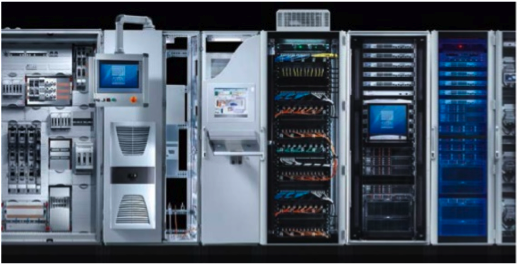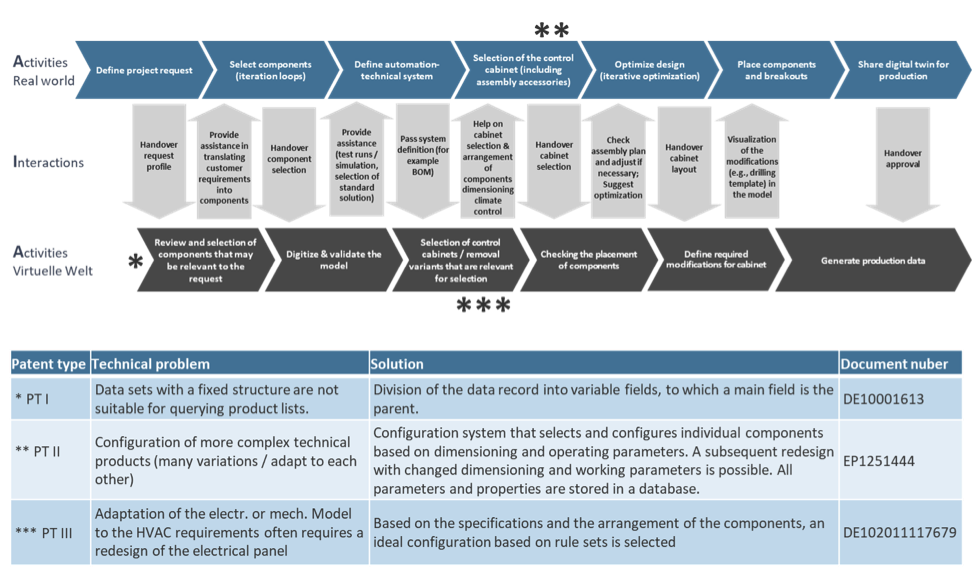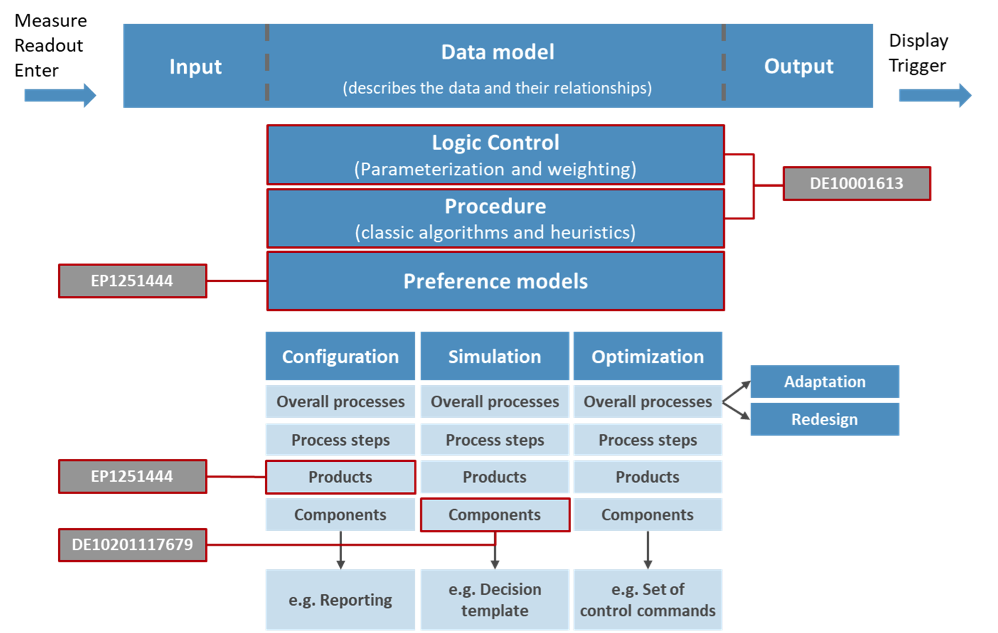Rittal is a showcase for industry 4.0: How to patent a digital twin?
Through consistent digitalization, Rittal achieves many goals that previously seemed hardly possible. The acceleration of processes in control and switchgear construction, the increase of profit margins, the reduction of personnel costs and the reduction of delivery times are made possible by digitalization at Rittal. The company is countering the enormous cost pressure in the industry by digitalizing the entire value chain and securing this position for itself through IP.
In modern switchgear and control engineering, the digital transformation of the value chain of the Friedhelm Loh Group, to which Rittal belongs, is a showcase for the Smart Factory as the implementation of the basic idea of Industry 4.0. Continuous digitalization and virtualization enable the constant expansion and improvement of automation as well as an increase in flexibility for batch size 1.
 This includes major increases in efficiency at all levels of the value chain, especially in the assembly of switchgear and control systems. The digitalization of the value chain is an enormous challenge on the IP side. On the one hand, it is important to ensure the freedom to operate a digital business model despite significantly higher innovation and patent dynamics and, on the other hand, to identify the central points in order to make the specific implementation of the value chain for Rittal exclusive. Building on this, the factors that enable Rittal to offer industry-wide USPs must be secured. Using the IP-design method, the digitalization of the value chain was analyzed, the neuralgic points were identified and finally an exclusivity position in the field of Industry 4.0 was secured for Rittal.
This includes major increases in efficiency at all levels of the value chain, especially in the assembly of switchgear and control systems. The digitalization of the value chain is an enormous challenge on the IP side. On the one hand, it is important to ensure the freedom to operate a digital business model despite significantly higher innovation and patent dynamics and, on the other hand, to identify the central points in order to make the specific implementation of the value chain for Rittal exclusive. Building on this, the factors that enable Rittal to offer industry-wide USPs must be secured. Using the IP-design method, the digitalization of the value chain was analyzed, the neuralgic points were identified and finally an exclusivity position in the field of Industry 4.0 was secured for Rittal.
The case study from the master’s program for Intellectual Property Law and Management (MIPLM) of CEIPI at the University of Strasbourg describes the protection of the digital value chain in control and switchgear construction: Smart factory showcase for Industry 4.0
The methodical anchoring of IP-design in the Rittal process landscape ensures that the technical creativity of employees can be used in a targeted and systematic manner to design the necessary protective rights.
The challenge of digital transformation and the digital twin
Two key technical developments are driving the digital transformation of the economy. On the one hand, there is the connection of humans and machines through the Internet via existing and new communication technologies, which permits new forms of communication, interaction, and work sharing. Virtually unlimited networking capacities generate a wealth of data, whose evaluation and use lead to new business models and services with great economic potential. The most important raw material of these new business models is data. On the other hand, this makes it easier to describe and simulate processes with algorithms and to create “digital twins” of the physical world. Apart from improved networking capabilities, the true disruptive potential of the digital transformation can be found in the virtualization of products and processes, which leads to some kind of data economy along the Industry 4.0 logic, because virtually everything can be described by means of data models and deployed in real time. This technical dimension of the digital transformation is easy to grasp when distinguishing between product and process level on the one hand and the physical and virtual worlds on the other (see next Figure).

How virtual prototypes or “digital twins” are used in the switchgear manufacturing process at Rittal can be seen in the following film.
Cannot open the video? Please click: https://youtu.be/7mnfLjU232E
IP-design example for a digital twin
Rittal employs scenario analysis in order to perform a precise analysis of the value chain and the individual sequences comprised in the larger steps. Adopting a dynamic perspective is crucial for the IP-design method of the application scenario. While descriptions of technical systems often rely on static visualizations, application scenarios deliberately refer to time sequences (storyline with activities). In the case of digital twins and cyber-physical systems in general, it is important to distinguish between the physical world and the virtual world. Precisely because of this distinction and the systematic description of interactions, approaches to inventions and therefore exclusivity potentials can be derived, for instance, along the value chain of Rittal.
It is also important that the description encompasses the entire reality space that is relevant to the application scenario. In addition to the environment, activities, and interactions, this also includes the objects involved in the action or subject to influence or interaction as well as the users. In order to precisely determine the crucial points at which Rittal must develop its own exclusivity positions within the scope of the business model and the 360° IP strategy, the entire cyber-physical system must be analyzed along the industrial value chain and across the various partner companies. The next figure shows an exemplary excerpt from the analysis along a cyber-physical business process and gives some patent type examples for relevant activities.

Examples of patent types in cyber-physical systems using the cabinet product life cycle as an example.
Those patent types can also be described in the taxonomy for digital patents (see next Figure).

Digitization Taxonomy – Patent Types (Examples)
Questions:
- The above shown film 1 describes how Rittal generates advantages in the value chain by using “digital twins” (term in the film: virtual prototypes) over the life cycle of a cabinet. Regardless of the benefits addressed in the film, there are several optimization opportunities through digital twins at each stage of the value chain. Please think about potential applications for digital twins at the different stages of the value chain and describe your use case:
- Group 1: Control cabinet planning and design
- Group 2: Production of the control cabinet (if necessary with batch size 1)
- Group 3: Assembly and installation of the control cabinet
- Group 4: Operation of the control cabinet (if necessary considering the modification of the systems which are operated via the control cabinet)
Now show that your use case is amenable to patent protection. Use the principle of the patent type for this. (A patent type is a class of established problem-solution combinations in the patent literature that refers to an aspect of a use case or business model that is worthy of protection. Thus, a patent type describes typical solutions to a particular technical problem. The taxonomy in the last figure provides an example of patent types in a digitization taxonomy.)
- For your selected use case, please identify three exemplary patents (patent types) that show which solutions are typically applied for the most important technical problems of the use case. Please locate these patents in the digitization taxonomy.
- Describe why you consider these patent types relevant for your use case. From this, please derive an aspect for the design of your use case that leads to the use case being accessible to patent protection.
Solutions
Group 1:
- Anahita AHOURAEI
- Audrey BASTARD
- Maria Daniela BOTTICELLI
- Valentine FAVROD
- Alexander GANGNUS
- Ivan GAUCI
- Jan GLUECKERT
Here is the solution of group 1:
Cannot open the video? Please click: https://youtu.be/OEmYRB9hsCg
Group 2:
- Nataliya HIRSKA
- Tobias LIPP
- Pierre LORIN
- Aurélie MESSIER
- Matthieu NORRANT
- Rudina Ann PESCANTE
Here is the solution of group 2:
Cannot open the video? Please click: https://youtu.be/zuqPSBqs2g4
Group 3:
- Nicolas RENAUD
- Adrien RENOULT
- Martin REYNARD
- Ricardo RODRIGUEZ CORTASA
- Vijay SHELKE
- Christian SLISSE
Here is the solution of group 3:
Cannot open the video? Please click: https://youtu.be/qQqXVhrCtX4
Group 4:
- Erica SMITH
- Russell THOM
- Rodrigo TRONCOSO
- Christine WALMSLEY-SCOTT
- Astrid WOOLLARD
- Xiaoqing ZHANG
Here is the solution of group 4:
Cannot open the video? Please click: https://youtu.be/SMlgWjLKiSM



